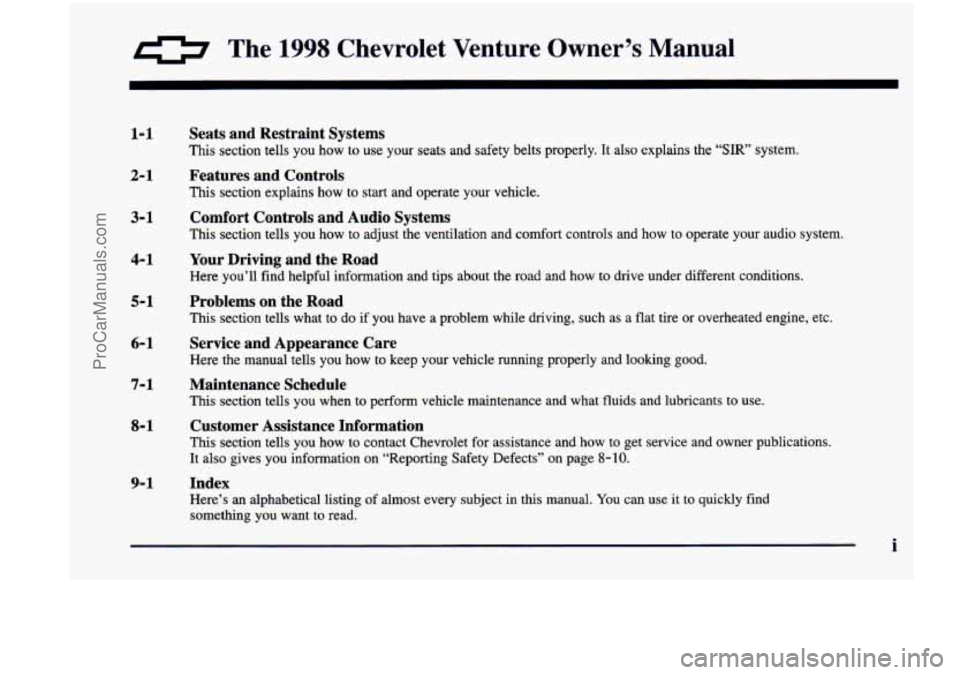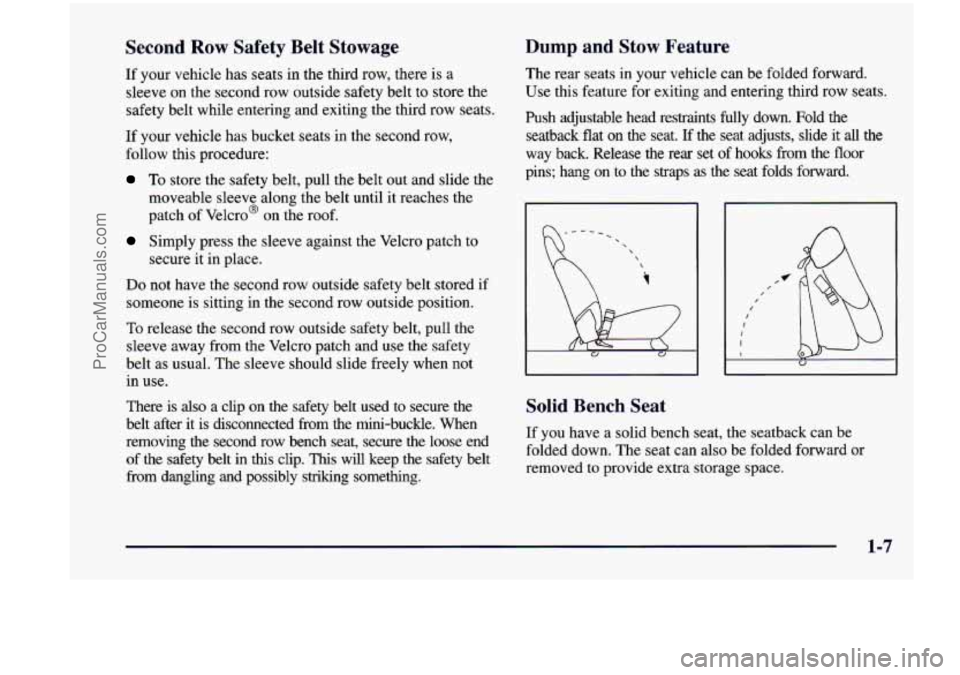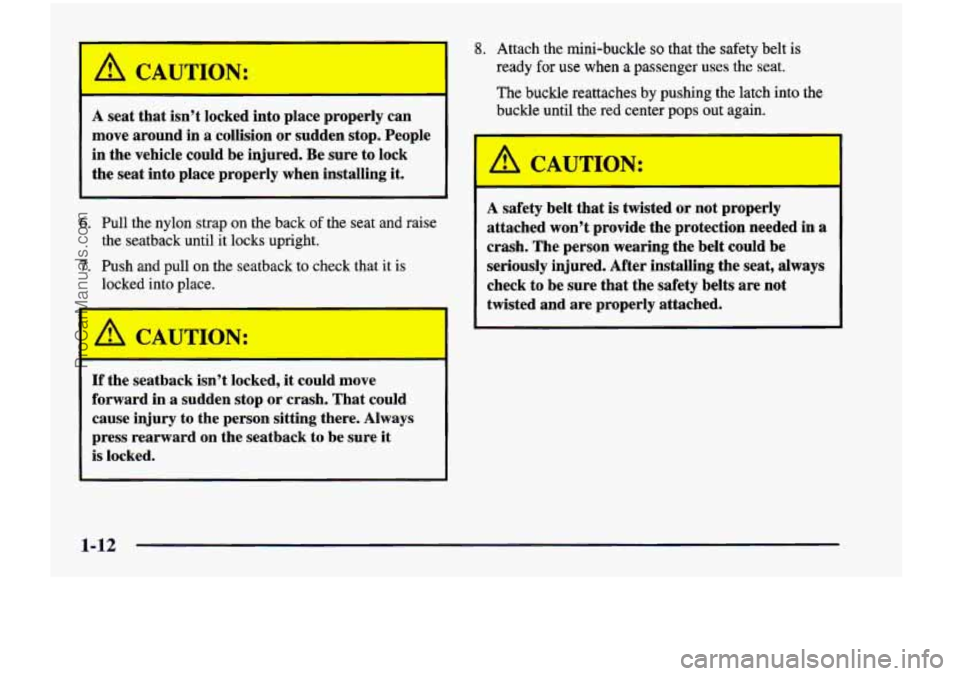Page 6 of 474

a The 1998 Chevrolet Venture Owner’s Manual
1-1
2-1
3-1
4- 1
5-1
6-1
7-1
8-1
9- 1
Seats and Restraint Systems
This section tells you how to use your seats and safety belts\
properly. It also explains the “SIR’ system.
Features and Controls
This section explains how to start and operate your vehicle.
Comfort Controls and Audio Systems
This section tells you how to adjust the ventilation and comfort co\
ntrols and how to operate your audio system.
Your Driving and the Road
Here you’ll find helpful information and tips about the road\
and how to drive under different conditions.
Problems on the Road
This section tells what to do if you have a problem while driving,\
such as a flat tire or overheated engine, etc.
Service and Appearance Care
Here the manual tells you how to keep your vehicle running pr\
operly and looking good.
Maintenance Schedule
This section tells you when to perform vehicle maintenance and \
what fluids and lubricants to use.
Customer Assistance Information
This section tells you how to contact Chevrolet for assistance \
and how to get service and owner publications.
It also gives you information on “Reporting Safety Defects” on page 8- 10.
Index
Here’s an alphabetical listing of almost every subject in this manual. You can use it to quickly find
something
you want to read.
i
ProCarManuals.com
Page 13 of 474
Vehicle Symbols
These are some of the symbols you may find on your vehicle.
For example,
these symbols
are used on an
original battery:
POSSIBLE A
CAUTION
INJURY
PROTECT EYES BY
SHIELDING
Q
CAUSTIC
BURNS AVOID
SPARKS
OR
FLAMES
SPARK
OR ,\I/,
COULD FLAME
EXPLODE BA'ITERY
These symbols
are important
for you and
your passengers
whenever your
vehicle is
driven:
DOOR LOCK
UNLOCK
FASTEN SEAT
BELTS
POWER
WlNDOW
These symbols
have to do with
your lamps:
SIGNALS e
TURN
FOG LAMPS
& 0
These symbols
are on some of
your controls:
WINDSHIELD WIPER
WINDSHIELD DEFROSTER
WINDOW
DEFOGGER
VENTILATING FAN
These symbols
are used on
warning and
indicator lights:
COOLANT -
TEMP -
CHARGING I-1
BAllERY
SYSTEM
BRAKE
(0)
COOLANT
a
ENGINE OIL e,
PRESSURE
ANTI-LOCK
(@)
BRAKES
Here are some
other symbols
you may see:
FUSE
LIGHTER m
HORN b
SPEAKER
cr
FUEL B
viii
ProCarManuals.com
Page 14 of 474
a Section 1 Seats r--Id Restraint Systems
m
Here you’ll find information about the seats in your Chevrolet and how to use your safety belts properly. You can also
learn about some things you should
not do with air bags and safety belts.
1-2
1-6
1-35
1-40
1-41 1-41
1-49 1-50
1-50
1-58 Seats and
Seat Controls
Rear Seats Safety Belts: They’re for Everyone
Here Are Questions Many People Ask About
Safety Belts
-- and the Answers
How to Wear Safety Belts Properly
Driver Position Safety Belt Use During Pregnancy
Right Front Passenger Position
Air Bag Systems
Rear Seat Passengers 1-62
1-64
1-66
1-68
1-7
1
1-82
1-98
1-101
1-101
1-102 Rear Safety Belt Comfort Guides
for Children
and Small Adults
Center Passenger Position (Bench Seat)
Center Passenger Position (Bucket Seat)
Children
Built-in Child Restraint (Option)
Child Restraints
Larger Children Safety Belt Extender
Checking
Your Restraint Systems
Replacing Restraint System
Parts
After a Crash
1-1
ProCarManuals.com
Page 18 of 474
But don’t have a seatback reclined if your vehicle
is moving.
Sitting in a reclined position when your vehicle is
in motion can be dangerous. Even
if you buckle
up, your safety belts can’t
do their job when
you’re reclined like this.
The shoulder belt can’t do its job because it
won’t be against your body. Instead, it will be in
front
of you. In a crash you could go into it,
receiving neck or other injuries.
The lap belt can’t do its job either.
In a crash the
belt could
go up over your abdomen. The belt
forces would
be there, not at your pelvic bones.
This could cause serious internal injuries.
For proper protection when the vehicle
is in
motion, have the seatback upright.
Then
sit well back in the seat and wear your safety
belt properly.
1-5
ProCarManuals.com
Page 20 of 474

Second Row Safety Belt Stowage Dump and Stow Feature
If your vehicle has seats in the third row, there is a
sleeve
on the second row outside safety belt to store the
safety belt while entering and exiting the third
row seats.
If your vehicle has bucket seats in the second row,
follow this procedure:
To store the safety belt, pull the belt out and slide the
moveable sleeve along the belt until it reaches the
patch of Velcro@ on the roof.
Simply press the sleeve against the Velcro patch to
Do not have the second row outside safety belt stored if
someone is sitting in the second row outside position.
To release the second row outside safety belt, pull the
sleeve away from the Velcro patch and
use the safety
belt
as usual. The sleeve should slide freely when not
in use. secure it in place.
There is
also a clip on the safety belt used to secure the
belt after
it is disconnected from the mini-buckle. When
removing
the second row bench seat, secure the loose end
of the safety belt
in this clip. This will keep the safety belt
fi-om dangling and possibly striking something. The
rear seats in
your vehicle can be folded forward.
Use this feature for exiting and entering third row seats.
Push adjustable head restraints fully
down. Fold the
seatback flat on the seat.
If the seat adjusts, slide it all the
way back. Release
the rear set of hooks from the floor
pins; hang on to the straps as the seat folds forward.
I I I I I
Solid Bench Seat
If you have a solid bench seat, the seatback can be
folded down. The seat can also be folded forward or
removed
to provide extra storage space.
1-7
ProCarManuals.com
Page 21 of 474
Second Row Solid Bench Seats
Folding the Seatback
To fold down the seatback,
pull the nylon strap on the
back of the seat.
Removing the Second Row Solid Bench Seat
With the seatback in the upright position, unhook the
side attachment for the safety belt.
This mini-buckle is
located on the right side
of the seat.
Push up the red center on
the buckle with a small
pointed object like a key
or pen.
To raise the seatback, pull the nylon strap on the back of
the seat while raising the seatback until it locks upright.
Push and pull on the seatback to check that it is locked. 1. Pull the nylon strap on the back of the seat to fold
the seatback forward.
ProCarManuals.com
Page 25 of 474

/1 CAUTION:
A seat that isn’t locked into place properly can
move around in a collision or sudden stop. People
in the vehicle could be injured. Be sure to lock
the seat into place properly when installing
it.
6. Pull the nylon strap on the back of the seat and raise
7. Push and pull on the seatback to check that it is
the seatback until it locks upright.
locked into place.
A CAUTION:
If the seatback isn’t locked, it could move
forward in
a sudden stop or crash. That could
cause injury to the person sitting there. Always
press rearward on the seatback
to be sure it
is locked.
1 8. Attach the mini-buckle so that the safety belt is
ready for use when a passenger uses the seat.
The buckle reattaches
by pushing the latch into the
buckle until the red center
pops out again.
-
A safety belt that is twisted or not properly
attached won’t provide the protection needed in
a
crash. The person wearing the belt could be
seriously injured. After installing the seat, always
check to be sure that the safety belts
are not
twisted and
are properly attached.
1-12
ProCarManuals.com
Page 33 of 474
Lift up either lever and
slide the seat forward to
allow for extra storage
seat back to allow extra
room for passengers.
~ behind the seat, or slide the
Release the lever. Push and pull on the seat to be sure it
is locked into place.
Removing the Split Bench Seat
Make sure the seatback is in the upright position and
that the safety belts are on the correct section
of the seat.
The head restraints should be fully down.
For the second row bench, with the seatback in the
upright position, unhook the side attachment for the
safety belt. This mini-buckle is located on the right side
of the seat. Push up the red center on
the buckle with a small
pointed object like
a key
or pen.
1. Lift the seatback recliner lever or pull the nylon strap
on the back of the seat to fold the seatback forward.
2. Slide the seat all the way back by lifting either one of
the adjustment bars and sliding the seat fully rearward.
1-20
ProCarManuals.com